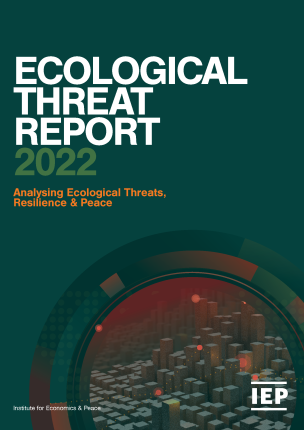-
Ecological Threats, Resilience and Peace: A New Assessment of Hotspots
November 7, 2022 By Marisa O. Ensor
Which nations are most at risk of catastrophic outcomes due to intensifying ecological threats? The third edition of the Institute for Economics & Peace (IEP)’s Ecological Threat Report (ETR)—released on October 20, 2022— applies a lens of societal resilience to predict the hotspots most likely to suffer from instability and conflict in the future, and provides projections of ongoing trends to 2050.
The new report surveys a dire global situation in which climate change continues to act as a threat multiplier in manifold ways, including population growth, clean water, and increasing climate disasters, as well as underscoring that the plans submitted by most signatories of the Paris Agreement are still not ambitious enough to meet climate goals.
The research upon which the report is built covers 99.99 percent of the world’s population, assessing threats relating to food security, water stress, population pressures, environmental disasters, and displacement. It takes a multidimensional approach, analyzing risk at the national, administrative district and city levels, and evaluating ecological threats, societal resilience, and levels of peace.
Where Are the Threats Most Acute?
The 2022 ETR identifies 27 hotspot countries—with a combined population of 768 million people—that face catastrophic ecological threats and have the lowest levels of societal resilience to navigate them. Two-thirds of hotspot countries are in sub-Saharan Africa (SSA), while countries in MENA account for another 18.5 percent. Seven of the eight hotspot countries with the highest risk are in SSA. These are Burundi, Central African Republic, Chad, Republic of the Congo, Somalia, South Sudan, and Uganda. The eighth country is Yemen.
The report finds that the world’s highest concentration of hotspot countries is in the Sahel region, which faces numerous social, political, and economic vulnerabilities and high rates of conflict and terrorism. Six of the ten countries (Chad, Cameroon, Guinea, Mali, Mauritania, and Nigeria) are classified as “hotspots,” meaning they have low levels of resilience and face at least one catastrophic ecological threat.
Rapid population growth and food insecurity in sub-Saharan Africa and parts of MENA have been stressors that create socio-political instability for the past 50 years or more. Water scarcity has strained international relations in MENA (where Turkey, Syria, and Iraq compete over the Euphrates-Tigris Basin) as well as between Egypt, Sudan, and Ethiopia in regards to the river Nile and the New Renaissance Dam project.
The report also points to the strong relationship between the number and intensity of ecological threats and conflict. Of the 12 countries to record a catastrophic level of ecological threat in all four ETR domains, six are currently in conflict, and another three are in a state of institutional and social fragility.
Diminishing Concern and Growing Unsustainability
The Ecological Threat Report not only identifies key regional hotspots, but also larger threat patterns that require concerted international action to prevent current levels of ecological degradation from substantially worsening and intensifying a range of social challenges including malnutrition, forced migration, and illness. Yet the report notes that concern over climate change is diminishing—especially in major polluting nations.
Among the most startling findings of the new research include the fact that the threat is broadly based. Fifty-six percent of the 228 countries and territories monitored by the ETR face extreme ecological threats, and the world’s 40 least peaceful countries are projected to see a population increase by 1.3 billion by 2050, and thus represent 49 percent of the world’s population. Yet even more problematic is the report’s projection that much of sub-Saharan Africa will be unsustainable by 2050, with a 95 percent population growth over this period.
The Way Forward
The 2022 ETR concludes that creating societal resilience and lowering high levels of conflict requires concerted international action to raise the levels of resilience in the most vulnerable countries.
International agencies need new integrated structures that operate systemically, combining health, food, water, refugee relief, finance, agricultural, development, and other functions. Indigenous peoples and local communities must be empowered and their rights respected. Locally-led approaches to development and human security offer more effective program design, easier implementation, and more accurate evaluation.
Ecological threats will continue to create humanitarian emergencies, increase conflict, and result in forced migration. The new report underscores how building resilience to these threats where they are most present must be top of the global agenda now and into the future.
Marisa O. Ensor is an applied environmental and legal anthropologist currently based at Georgetown University’s Justice and Peace Studies Program.
Sources: Institute for Economics & Peace, InterAction, International Union for Conservation of Nature, Intergovernmental Panel on Climate Change; United Nations Framework Convention on Climate Change, World Bank.
Photo Credit: Cover of Ecological Threat Report 2022: Analysing Ecological Threats, Resilience & Peace, courtesy of the Institute for Economics & Peace.
 A Publication of the Stimson Center.
A Publication of the Stimson Center.



